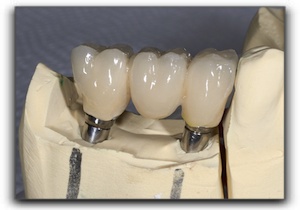When you receive an implant, a dental crown is a final component.
Let’s discuss the complex process required to engineer a dental crown.
Dental crowns can be fabricated with metal, ceramic (porcelain), resins, or varying combinations of these.
As far as beauty goes, today’s high-quality crowns are just as pleasing and natural-looking as authentic teeth. (A crown that looks like a white Chiclet and sticks out like a sore thumb is not a high-quality crown from Cary Family Dental.)
To create a model for the crown, a dental assistant makes an impression of all the teeth. The impression is sent to a lab where the plaster teeth are separated. The individual tooth mold in need of restoration is scanned into a computer to have accurate dimensions to send to the lab.
The technologically-advanced lab has a computerized machine that pours plaster into cylindrical molds, resulting in blanks. Once hardened, the process of making the tooth from the plaster blanks begins.
The machine takes the scanned data from the impression and begins carving out the contours found in the scan. The finished tooth is not to scale, being 20% to 30% larger than needed. This enlargement is to allow for material shrinkage that will later occur.
The machine then dips the plastered tooth into liquid ceramic. The ceramic hardens and gives the tooth a gleaming, natural finish that is indistinguishable from a genuine tooth. The machine then starts a new process of orienting the tooth with others. This time, ceramic powder is poured into new molds over the plaster tooth. The molds are put on a rod and then plunged into a water-filled chamber. Once the chamber lid is closed, water pressure increases, solidifying each ceramic tooth.
The restoration is then chiseled to perfectly match the plastered tooth that is inside. This tooth becomes the ceramic shell of the crown and is easily lifted off the plastered tooth.
This shell, or coping, is then exposed to a high temperature for increased durability. It also shrinks to the proper size. Once finished, a plastic replica of the original tooth is created from the computer scan. The new shell is then tested for precise fitting over the tooth.
The next step is the application of layers of colored porcelain. A skilled ceramist—an artist in every sense of the word—may apply up to 15 layers of porcelain to perfectly match the variations in the surrounding teeth. This labor-intensive job accounts for much of the cost of a high-quality crown.
The crown is then fired to making the porcelain more impenetrable throughout. More hand contouring follows, as required. The final step is the application of a clear, ceramic gloss.
This intensive process results in a phenomenal crown for one of our patients!
Contact Cary Family Dental:
919-371-4428
Location (Tap to open in Google Maps):
1149 Kildaire Farm Rd
Cary, North Carolina
27511




